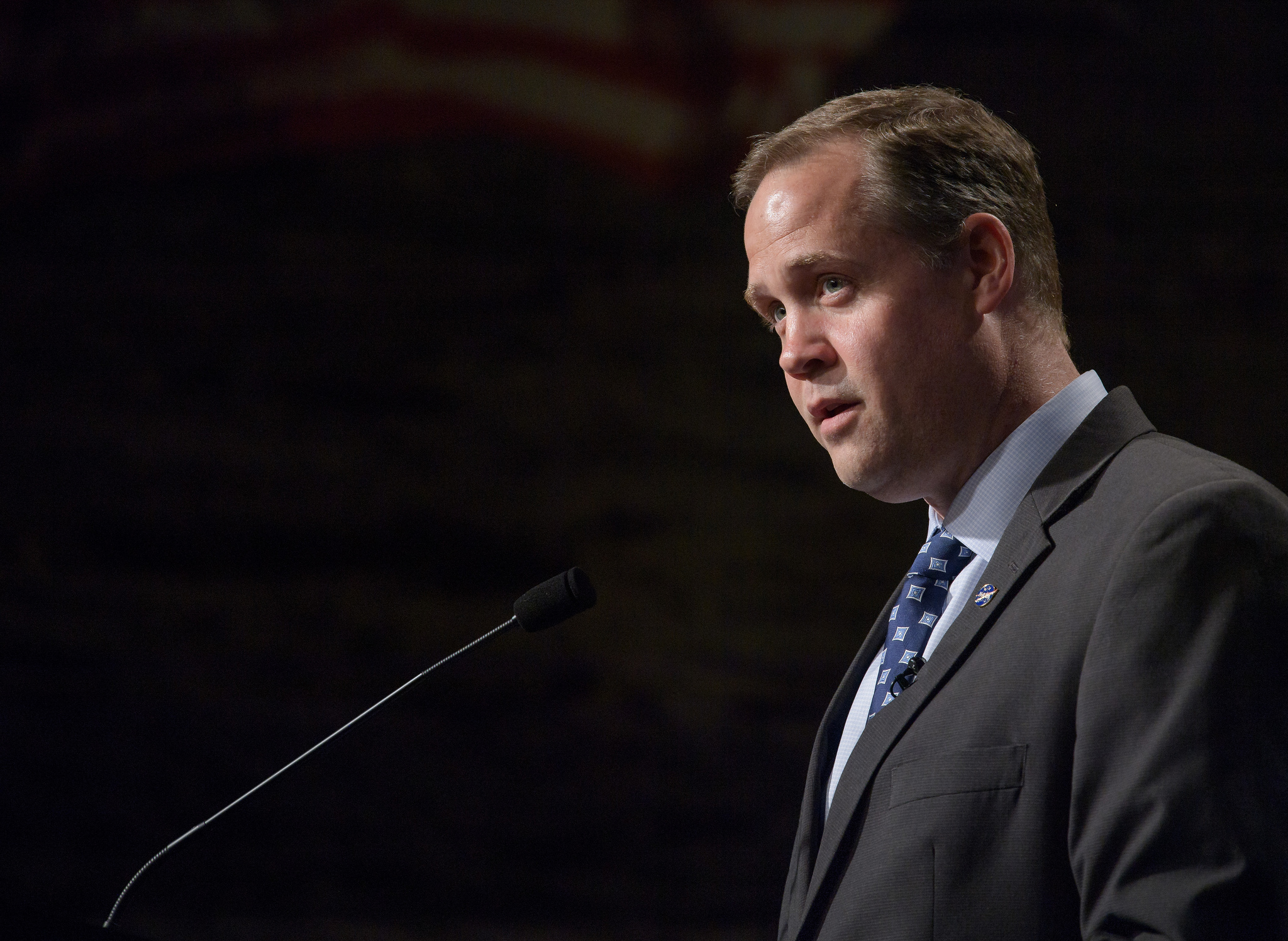New NASA Chief Sees Moon Missions Building a 'Railroad' to Mars
In his first major address as NASA administrator, Jim Bridenstine defended the new agency directive to go to the moon first before voyaging to Mars. But his webcast speech at the Humans to Mars summit in Washington, D.C., today (May 9) did not disclose any new initiatives by NASA to send humans to the Red Planet.
Bridenstine, the former Republican congressman from Oklahoma's 1st District, was sworn in as administrator three weeks ago after NASA went 15 months without a permanent leader. While the agency was under interim leadership, the Trump administration tasked NASA with taking humans back to the moon before going to Mars. [Presidential Visions for Space Exploration: From Ike to Trump]

Bridenstine told delegates that Mars and the moon will be complementary initiatives. In March, he said, the agency sent a request for information to U.S. industry asking for ideas to improve lunar payload transportation to orbit and to the moon, culminating with human landers. "If some of you are concerned that the coming focus is the moon, don't be," Bridenstine said.
"We're doing both the moon and Mars in tandem, and the missions are supportive of each other," he added. "Our return to the surface of the moon will allow us to prove and advance technologies that will feed forward to Mars." Examples of such technologies will include systems for surface mobility, surface habitation, long-duration life support and precision landing, he said.
Building a railroad
The key to success in space will be to encourage commercial players to move beyond low Earth orbit and deeper into space, Bridenstine said. He likened today's situation in space to the 1800s, when America's West was a frontier and it was difficult for the country to take advantage of it economically.
In 1803, Thomas Jefferson asked U.S. Army Capt. Meriwether Lewis and 2nd Lt. William Clark to lead Army volunteers westward. The land had just been acquired under the Louisiana Purchase, and Jefferson wanted to know what was there — including "descriptions of animals, vegetables, minerals and other strange things," Bridenstine said. Their expedition ran from 1804 to 1806.
But it wasn't until the 1860s that the government could take full advantage of the western frontier, Bridenstine said. Twice, in 1860 and 1861, the U.S. House of Representatives passed bills to build a transcontinental railroad, which the Senate twice refused. (While Bridenstine didn't mention why, one major obstacle was the ongoing American Civil War.) The first Pacific Railroad Act was finally established in 1862, allowing for commercial expansion, Bridenstine said.
Get the Space.com Newsletter
Breaking space news, the latest updates on rocket launches, skywatching events and more!
Bridenstine then recalled July 20, 1969, when the first Apollo mission landed on the lunar surface. He called Apollo 11's surface crew, Neil Armstrong and Buzz Aldrin, a modern Lewis and Clark. "I know Buzz Aldrin is here, and he would tell you that Buzz Aldrin is Buzz Aldrin," Bridenstine joked. But he said that 49 years after that landing, it's time for the U.S. to build its own railroad in space. And he said NASA is already starting with two robotic Mars missions. [Missions to Mars: A Robot Red Planet Invasion History (Infographic)]
InSight and Mars 2020
NASA's InSight Mars lander launched from Vandenberg Air Force Base in California on Saturday (May 5) on a mission to probe deep into the Red Planet's interior. Bridenstine pointed out it was a government mission, built by American industry, inclusive of international partners, sent to a U.S. Air Force base launchpad and launched on a commercial rocket. This diverse partnership, he said, is "evidence that we are building the railroad, tie by tie, stake by stake."
InSight's main goal is to better understand the evolution of rocky planets, but Bridenstine said its findings will also help humans assess the exploration risks of Mars. Since Mars is closer to the asteroid belt, it has its own meteor showers. It also has a thinner atmosphere, meaning that more meteorites might strike the surface. The risk of meteorite strikes is poorly known, he said, along with our understanding of marsquakes and volcanic activity. "We'll be better informed and better prepared," he said.
The forthcoming Mars 2020 rover mission is focused on searching for potentially habitable environments, including caching samples for a possible sample return to Earth. But it will also carry an experiment called MOXIE (Mars Oxygen In-Situ Resource Experiment) to test a method for processing oxygen from Mars' atmosphere of mostly carbon dioxide. This could be useful for future missions, Bridenstine said.
Bridenstine added that NASA's forthcoming powerful Space Launch System rocket, and the Orion deep-space spacecraft, will also be important pieces of the plan, allowing astronauts to "explore where an economy does not exist."
The Humans to Mars summit continues until tomorrow (May 10), and you can watch the proceedings live here at Space.com, or directly via the conference website: https://livestream.com/viewnow/HumanstoMars2018
Follow us @Spacedotcom, Facebook and Google+. Original article on Space.com.
Join our Space Forums to keep talking space on the latest missions, night sky and more! And if you have a news tip, correction or comment, let us know at: community@space.com.

Elizabeth Howell (she/her), Ph.D., was a staff writer in the spaceflight channel between 2022 and 2024 specializing in Canadian space news. She was contributing writer for Space.com for 10 years from 2012 to 2024. Elizabeth's reporting includes multiple exclusives with the White House, leading world coverage about a lost-and-found space tomato on the International Space Station, witnessing five human spaceflight launches on two continents, flying parabolic, working inside a spacesuit, and participating in a simulated Mars mission. Her latest book, "Why Am I Taller?" (ECW Press, 2022) is co-written with astronaut Dave Williams.









